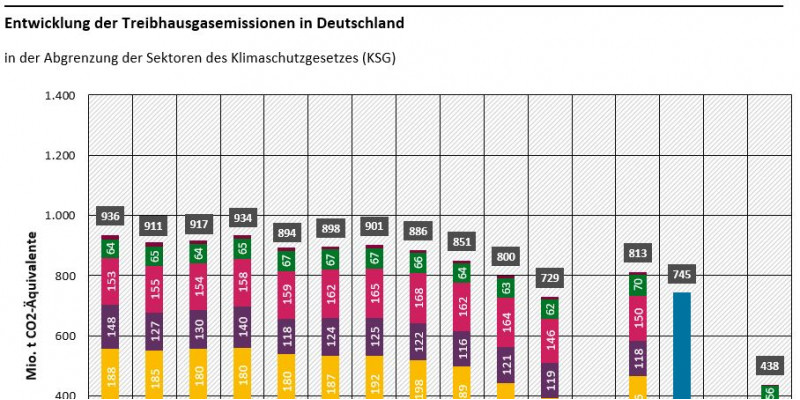Patrick Graichen, State Secretary at the Federal Ministry for Economic Affairs and Climate Action, said: “We are facing an enormous climate policy challenge. We need to step up the pace and actively shape the transformation of our economy and society. Our climate targets require nearly a tripling of the current pace of mitigation by 2030. We urgently need to implement additional measures affecting all sectors to comply with the annual emission levels in the Federal Climate Change Act. By launching the immediate climate action programme, we are now getting all the necessary laws and measures for this underway."
UBA President Dirk Messner said: “The coronavirus pandemic brought emissions way down in 2020. This is not due to last though as our initial forecasts show an uptick in emissions for 2021. If Germany is to become climate-neutral by 2045, we need more energy from the wind and the sun, more electromobility and a shift in heating towards renewable sources of energy, as well as a fundamental transformation of industrial production. The first steps have been taken, and now all departments must start implementing them.” UBA is publishing a complete forecast of 2021 CO₂ emissions on 15 March 2022.
The energy industry significantly reduced its greenhouse gas emissions in 2020, by 38.1 million tonnes, that is, by 15.2%. There was a markedly strong decline in the use of lignite and hard coal. In contrast, the use of lower emissions natural gas increased slightly due to lower prices and comparatively high prices for CO₂ certificates. Electricity production from renewable energy sources jumped, in particular due to favourable weather conditions for onshore wind energy. Power consumption decreased because of the coronavirus crisis, which in turn led to an unexpectedly high cut in emissions. This is despite the decommissioning of the Philippsburg 2 nuclear power plant at the end of 2019, which decreased the amount of electricity produced from nuclear energy. The largest share of emissions reduction can be traced to lignite. Further power generation units were put on security standby in 2019, thus also lowering 2020 emissions. Production of electricity using hard coal dropped once again despite a significant slowdown in 2019 and the commissioning of the Datteln 4 power plant in 2020.
Household emissions rose by 0.3 million tonnes of CO₂ equivalents (0.3%) whilst emissions from commerce, trade and the services sectors shrank by 2 million tonnes of CO₂ equivalents (- 7%). Lockdown conditions caused emissions to decrease as restaurants, theatres, swimming pools, etc. remained closed. In contrast, there was a slight uptick in heating oil sales due to its favourable price and in anticipation of national emissions trading in the fuel sector starting 2021. However, this inventory effect was much weaker than in 2019.
Transport sector emissions in 2020 fell well below the previous year's level, also the car fleet continued to grow for the 13th year in a row. The sector recorded emissions of 147.2 million tonnes of CO₂ equivalents, which is just under 11 percent less than 1990 levels. Passenger car emissions actually fell by 13 percent over the previous year. Most of this reduction can be attributed to the fact that, on average, significantly fewer cars were driven because of the coronavirus pandemic. More electric cars and higher blending of biofuels contributed significantly less to the decline in emissions. The mileage of heavy goods vehicles was only slightly lower than in the previous year despite the pandemic, and emissions from commercial vehicles fell by five percent. Domestic aviation emissions fell significantly in terms of percentage (-53%).
So-called “diffuse” greenhouse gas emissions, for example mine gas, decreased over the previous year by 0.4 million tonnes of CO₂ equivalents (5.1%).
Industrial process emissions decreased significantly by more than 7 percent, or 4.3 million tonnes of CO₂ equivalents. Economic effects in the wake of the coronavirus pandemic play an important role here, although they differed from sector to sector. The most significant reduction was in the steel industry, notably in crude steel production. The manufacturing industry saw mostly slight decreases in emissions.
Emissions in the agriculture sector declined slightly 0.8 million tonnes to 56.1 million tonnes of CO₂ equivalents and thus continuing the trend of previous years. The causes for this are a relatively low use of mineral fertilisers, a declining cattle stock and continued dry weather conditions.
Emissions by greenhouse gas
Carbon dioxide (CO₂) continues to dominate greenhouse gas emissions in 2020 with a share of almost 88% – most of which comes from the combustion of fossil fuels. The remaining emissions are divided between methane (CH₄) (6.7%) and nitrous oxide (N₂O) (just under 4%), predominantly from the agricultural sector. Compared to 1990, emissions of carbon dioxide were down by 39.2%, methane by 58.7% and nitrous oxide by 51.4%.
Fluorinated greenhouse gases (F-gases) account for only about 1.7% of greenhouse gas emissions in total, but some of them have a very high global warming potential. Since 1995, fluorinated greenhouse gas emissions have fallen by 28.9%.
Background: Effort-Sharing-Decision (ESD)
The effort-sharing legislation set binding annual targets for EU Member States to reduce greenhouse gas emissions in the periods 2013-2020 and 2021-2030. These targets cover emissions from most sectors not covered by the EU ETS, such as transport, buildings, agriculture and waste, but also parts of the industrial sector.
The EU Commission is responsible for the exact calculation of the emissions relevant for the ESD and thus also of any necessary additional purchases of certificates from other Member States. In addition to credits from previous years and the purchase of additional certificates, an excess can also be offset against possible savings in 2020.
Further information
The changes compared to the published first estimate of GHG emissions for 2020 (see press release 07/2021 of 15.03.2021) are due to updates of the preliminary statistical information at that time.
In accordance with the Climate Change Act, UBA will present the official estimate for 2021 emissions in mid-March 2022.
 Click to enlarge
Click to enlarge

